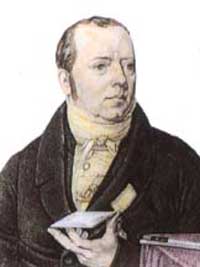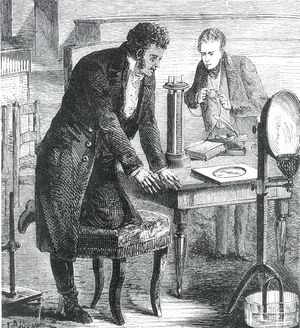- Birthdate
- 1777/08/14
- Birthplace
- Rudkøbing, Langeland, Denmark
- Death date
- 1851/03/09
- Associated organizations
- Polytechnic Institute in Copenhagen
Biography
Hans Christian Ørsted was born at Rudkøbing, Langeland, Denmark, on 14 August 1777, the elder son of an apothecary (pharmacist). Because the demands of the pharmacy were high, the parents placed Hans Christian and his younger brother Andres Sandøe with a local German wigmaker and his wife for their early education. The brothers quickly learned German by translating a German Bible. Their intellectual ability was soon clear and neighbors did their best to educate them. This education was enough to earn the brothers admission to Copenhagen University in 1794. At the University, Ørsted studied astronomy, physics, mathematics, chemistry, and pharmacy. In 1797, Ørsted received his degree in pharmacy and in 1799 completed his Ph.D. By 1806 Ørsted gained a professorship at the University of Copenhagen.
Ørsted was influenced by the philosophy of Immanuel Kant, who believed that all the forces of nature were the consequence of two underlying fundamental forces—attraction and repulsion. This idea probably led Ørsted to his important discovery: the unity of electricity and magnetism—electromagnetism. Contemporary thinkers believed that electrical and magnetic forces were quite distinct. Although their laws of action had many similarities, their nature was thought to be different. In 1813, Ørsted suggested that there should be a connection between electric and magnetic phenomena, but he did not discover this connection experimentally until 1820. While lecturing to his students, he noticed that a magnetized compass needle nearby was disturbed when an electric current passed through a very thin platinum wire. He noted that the experiment made no strong impression on his audience. Even he was not sure that the effect was the one he had anticipated. He therefore continued his experiments during the summer of 1820 and published his results in a short paper. Upon publication of the paper, the importance of Ørsted's discovery was quickly recognized and led André-Marie Ampère to his description of the way in which an electrical current produces a magnetic field.
About this time Ørsted also made significant discoveries in chemistry. In 1820 he discovered piperine, one of the pungent components of pepper, and in 1825 he isolated metallic aluminium using electricity, however given the amount electricity required, and the difficulty of generating any quality of electricity at that time, Aluminium was classed as a rare-precious metal.
Ørsted was a gifted lecturer and spent much effort in popularizing science by writing in popular journals. In 1824 he founded a society devoted to the spread of scientific knowledge among the general public. Since 1908 this society has awarded the Ørsted Medal for outstanding contributions by Danish physical scientists. He became director of the Polytechnic Institute in Copenhagen in 1829. Additionally, Ørsted participated in the development of the galvanometer. He also devoted considerable time to his philosophical ideas. In his last paper, “The Soul in Nature,” he proposed a harmony between Spirit and Nature. The publication was left unfinished when he died on 9 March 1851.
In 1932 the word “Oersted” was adopted for the SI physical unit of magnetic field strength and in 1993 to the first Danish communications satellite.

